Abstract
Background: Elimination of suicide attempts is impossible, but they can be reduced dramatically by an organized planning. The present study aimed to survey the suicide trends in Fars province (Iran), during 2004-2009 to better understand the prevalence and status of suicide.
Methods: This survey was a cross-sectional study. The demographic data were collected from the civil status registry between 2004 and 2009. Suicide and suicide attempt data were collected of three sources including the affiliated hospitals of Shiraz University of Medical Sciences, mortality data of Vice Chancellery of Health in Fars province and data from forensic medicine. Then, they were analyzed by Excel and SPSS. Chi-square and regression analyses were used for data analysis.
Results: During the study, 10671 people attempted suicide, of which 5697 (53%) were women and 4974 (47%) were men. Among them, 1047 people (9.8%) died, of which 363 (34%) were women and 679 (64%) were men. There was a significant relationship between gender and fatal suicide. The mean suicide attempt for both genders was 53 per 100,000 and 49, 57 for men and women, respectively. The trends in the incidence of Suicidal attempts were decreasing.
Conclusion: Without implementing effective preventive measures, the health care system in Iran will face a further burden of fatal suicides among young people. Therefore; enhancing the primary health care and specialized mental health services for those with unsuccessful suicide attempts can effectively reduce the burden of suicide.
Keywords: Fatal Suicide, Suicide Attempt, Epidemiologic Trend
Background
Suicide is the most disastrous outcome of depression and frustration. Social problems and frustration are the causes of most suicides (1–3). Suicide is forbidden by most communities, some societies consider it as a crime and most of religions including Islam consider it as a sin (2,4). Although suicide has occurred in all the cultures even in primitive ones, it is most common in industrial communities. For example suicide is the 11th leading cause of death in USA, accounting for 2.1% of total deaths in this country (5). According to the statistics, one person commits a suicide every minute and every 18 minutes, one person dies because of suicide in USA (6–8). In central European countries (Hungary and Austria) and Northern Europe (Denmark and Finland) the highest percent of suicide is reported. The lowest suicide belongs to Asian countries and Muslim communities (9,10).
In regards to risk factors, depression is an important risk factor for suicide and 85% of the people attempting a suicide suffer from major depression. Such persons attempt suicide 25 times more in comparison to healthy population. People who attempt suicide have suicidal tendencies for a limited period and the problems are eliminated after the depression is treated (1,9,11). Even high rate of suicide among women is partly due to depression and of course other social problems. It has been frequently reported that men and women are different in terms of suicidal attempts and therefore in their outcomes (12–14). However, recent reports show that such differences among men and women have reduced over time (15). Regardless to gender, suicide is rarely occurred among children. Research shows that less than 200 cases of children below 14 years attempt suicide per year in US. The children with suicide tendencies are over excited and hyperactive (9,16,17).
In fact eliminating suicide is impossible but it can be reduced considerably by applying preventive measures. In order to understand the effect of different strategies on the incidence of suicidal attempts and deaths, epidemiological studies can be of great importance (15,18). This study investigates the trends in Fars province (located in the southwest of Iran with more than 4 million population) in a five year period, from 2004–2009.
Methods
Study Population
Fars province is the most populated province the Southwest Iran and based on the census data of 2011, 4,585,300 people reside in Fars. This survey was a cross-sectional study. The demographic data of Fars province during 2004 to 2009 (5 years) were collected from the Fars organization of civil registration; completed suicide and suicidal attempts data were collected from three sources: hospitals affiliated to Shiraz University of Medical Sciences, mortality data of Vice Chancellery of Health in Fars province and forensic medicine data. Although no one can claim that such sources can cover all suicidal attempts, they include most of the cases of death from suicide. It should be mentioned that our data did not cover two main cities in Fars province: Jahrom and Fasa.
Analysis
The average population of the province in each year was used to calculate the incidence of suicide for that year. The collected data were coded and registered into a computer by standard forms in accordance with revisions of the International Classification of Diseases-tenth revision (ICD-10). Repetitions were eliminated by matching the cases by first name, family name and father’s name. Then, they were analyzed by Excel 2007 and SPSS 19 (SPSS Inc., Chicago, IL, USA), using chi-square and two independent samples t-test where appropriate. In order to investigate the underlying trends in the incidence of suicide, we used Poisson regression. Level of significance for all analyses was P<0.05.
Results
During 2004-2009, a total of 10671 people attempted suicide, of whom 5697 (53%) were women and 4974 (47%) were men. Among them, 1047 people (9.8%) died, of whom 363 (34%) were women and 679 (64%) were men (P<0.001).
During the period of study, the average suicidal attempts for both genders was 53 per 100,000 of which this rate for men and women was 49/100,000 and 57/100,000 respectively. The suicidal attempt trend has been decreasing and this falling trend for men and women (y=-0.39 month+71) was significant (P<0.001; Figure 1).
Figure 1.
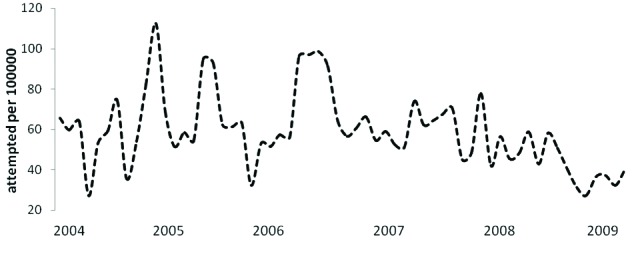
The incidence rate of attempted suicide in terms of sex
As it is shown in Figure 2, the mortality rate of suicide for women was decreasing (y=-0.08 month+5) while the figures for men was increasing (y=+0.08 month+8). However, the ascending and descending trends were not statistically significant. Totally, completed suicide for people over 10 years (no death reported under ten years of age) was 5.46 per 100000 and this value was 6.8, 4.1 per 100000 for men and women, respectively (Figure 2). However, the proportion of completed suicide in both genders increased over the period of study (P<0.001; Figure 3).
Figure 2.
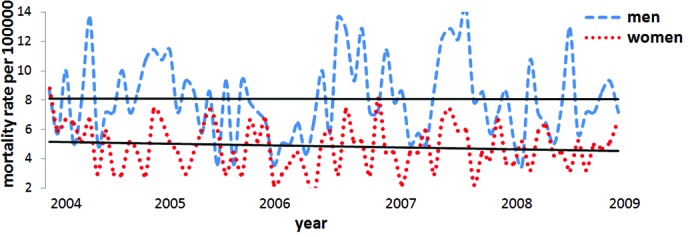
The mortality rate of suicide above 10 years old in terms of
Figure 3.
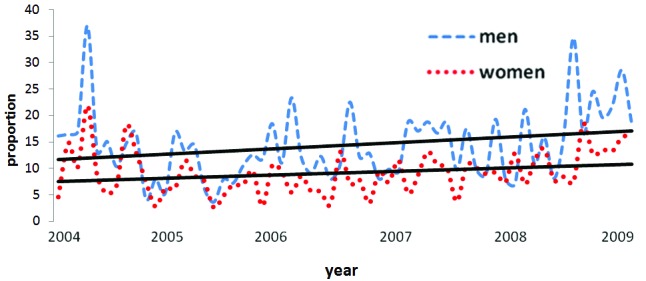
The proportion of completed suicide attempts in terms of sex
Other results showed that the number of completed suicide attempts has decreased among the 10-20 (y=-0.04 month+5) and over 40 years groups (y=-0.007 month+3). However the value has risen for the 20-40 age groups (y=0.02 month+9) (P<0.001; Figure 4).
Figure 4.
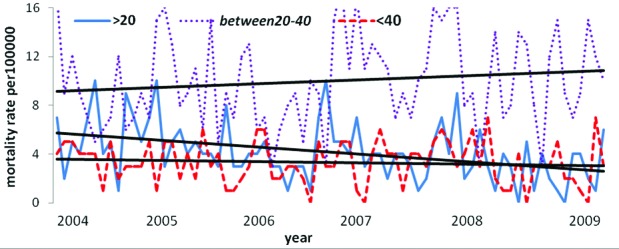
The mortality rate of suicide in terms of age group
Completed suicide attempt cases in terms of residential region showed an increase in the mortality rate of urban areas(y=0.01 month+3) but little changes were observed in rural areas (y=-0.01 month+2) (P<0.001; Figure 5).
Figure 5.
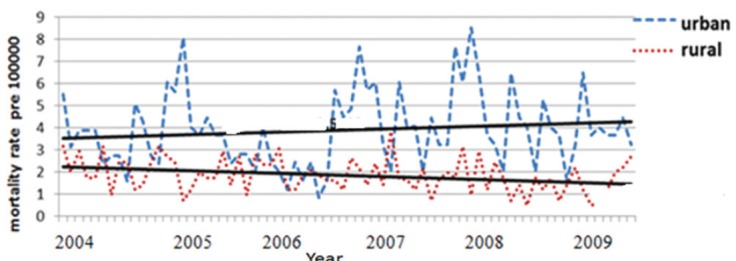
The mortality rate of suicide in terms of residential region
Discussion and Conclusion
As cities are different in terms of cultural, social and economical status, different reports of suicide rates are observed in various studies (19–22). On the other hand, in most studies, the adjustment method of suicide rates is not similar. Thus, the best solution is to compare the suicide rate in a region with the international data provided by WHO (3,9,23). In this study, the proportion of completed suicide was about 10% which was lower than the world average ranging between 10% to 20% (10,24). The suicidal attempt rate was 53 per 100000 which was lower than the average rate reported in studies performed in the west of Iran and at the country level but it was higher compared to the northern regions in Iran (25–29). It should be noticed that the figures account for people who referred to hospitals and clinics in Fars province. Those with minor complications who either did not seek health care or hid their attempt are not included in the suicidal attempt rates. Like other studies, our results showed that while suicidal attempt figure was higher for women, but men had a greater rate of completed suicide (30,31). As it was mentioned before, in this study the completed suicide rate was calculated for people over 10 but mortality rate was much lower than the world average based on WHO statistics of 26.9 and 8.2 per 100000 for men and women, respectively (10,15).
According to the results of Figures 1, 2, 3, we can say that the reason for little changes in mortality rate due to suicide while there was reduction on suicidal attempts was because of the increase of the proportion of completed suicides. According to Figure 4, during 2005-2006, the highest completed suicide was observed among the age group of 10–20 years old. This finding was consistent with the studies performed in 10 provinces of Iran (10,32,33). After 2006, there was a descending trend in the number of completed suicide attempts in the age groups of 10-20 years and over 40 years, while, the age group of 20-40 years showed an ascending trend. Comparing the average fatal suicide attempts during these years, reported in the previous studies conducted in Iran, we can find out about the ascending trend of completed suicide at age group of 20 to 40 years. Findings of the present study shows that mortality rate in urban and rural areas were increasing and to some extent constant, respectively. These findings showed a harmony with the previous studies performed in Kermanshah and Western Azerbaijan (29,34,35). As the study population was not definite, these changes might have been because of immigration and urbanization.
According to the results of our study, we can say that suicide rate was low in Fars province compared to other provinces of Iran and most parts of the world. As suicide occurs at young age, it is a major problem (36). Therefore, it is important that preventive measures be taken into account at two stages: before suicide attempt and after suicide attempt in cases of failed attempts. Most people who attempt suicide are likely to discuss it with their physician or relatives about 6 months earlier (37,38). This can be used as a factor to identify people susceptible to it (38–40). Fortunately, an integrated system of primary health care in all rural and urban areas in Iran has been developed from many years ago. One of the services offered in all primary health care clinics is mental health services. Expansion of these services can be very effective in reducing the rate of suicide attempts. As it is shown in this study and other studies, most people who attempt suicide have failed attempts and should be hospitalized in a safe place to go through the crisis and have the opportunity to get good therapeutic measures (40–42). In case of an unsuccessful suicide attempt, a more specialized mental health services can be very effective. Such services with the involvement of psychiatrists plus family and community support can effectively reduce subsequent suicide attempts which in turn reduce death from suicide.
One of the limitations of this study is that it suffers from under report of suicide attempt. Not all such cases are referred to hospitals as suicide attempt is against the social value in most Muslim countries such as Iran. However, in terms of successful suicides, our study is reliable. In fact, mortality data in Iran has an acceptable coverage with acceptable validity for causes such as suicide which is reported by both ministry of health and forensic medicine (43).
Iran is a young country and like other developing countries, most suicides occur in active and young people. The increase in the proportion of successful suicide among people aged 20–40 years old is an alarming issue that needs to be addressed effectively by health and social policy makers. Without implementing the effective preventive measures, the urban and young population in Iran will face a considerable burden of suicide during next years.
Acknowledgments
Our gratitude goes to the Centers for Health Promotion and Non-Communicable Disease Control, Deputy for Health, Shiraz University of Medical Sciences.
Citation: Najafi F, Hasanzadeh J, Moradinazar M, Faramarzi H, Nematollahi A. An epidemiological survey on the trends of the suicide incidence in the south�west Iran, 2004-2009. International Journal of Health Policy and Management 2013; 1: 219–222.
Footnotes
Ethical issues
Not applicable.
Competing interests
None.
Authors’ contributions
MM and FN both contributed to the data analysis and interpretation. All authors participated in drafting and revising the manuscript and approved the final version.
References
- 1.Hawton K, Harriss L, Hodder K, Simkin S, Gunnell D. The influence of the economic and social environment on deliberate self-harm and suicide: an ecological and person-based study. Psychol Med. 2001;31:827–36. doi: 10.1017/s0033291701003993. [DOI] [PubMed] [Google Scholar]
- 2.Lewis G, Sloggett A. Suicide, deprivation, and unemployment: record linkage study. BMJ. 1998;317:1283–6. doi: 10.1136/bmj.317.7168.1283. [DOI] [PMC free article] [PubMed] [Google Scholar]
- 3.Bertolote JM, Fleischmann A. A global perspective in the epidemiology of suicide. Suicidologi. 2002;7:6–7. [Google Scholar]
- 4.Tuohig GM, Saffle JR, Sullivan JJ, Morris S, Lehto S. Self-inflicted patient burns: suicide versus mutilation. J Burn Care Rehabil. 1995;16:429–36. doi: 10.1097/00004630-199507000-00009. [DOI] [PubMed] [Google Scholar]
- 5.McGinnis JM, Foege WH. Actual causes of death in the United States. JAMA. 1993;270:2207–12. [PubMed] [Google Scholar]
- 6.Wasserman D, Cheng Q, Jiang GX. Global suicide rates among young people aged 15-19. World Psychiatry. 2005;4:114–20. [PMC free article] [PubMed] [Google Scholar]
- 7.Maghsoudi H, Garadagi A, Jafary GA, Azarmir G, Aali N, Karimian B. et al. Women victims of self-inflicted burns in Tabriz, Iran. Burns. 2004;30:217–20. doi: 10.1016/j.burns.2003.10.010. [DOI] [PubMed] [Google Scholar]
- 8.Lopez AD, Murray C. The global burden of disease. Nat Med. 1998;4:1241–3. doi: 10.1038/3218. [DOI] [PubMed] [Google Scholar]
- 9.Krug EG, Mercy JA, Dahlberg LL, Zwi AB. The world report on violence and health. Lancet. 2002;360:1083–8. doi: 10.1016/S0140-6736(02)11133-0. [DOI] [PubMed] [Google Scholar]
- 10.Hatami H, Razavi M, Eftekhar H, Majlesi F, Seyed Nozadi M, Parizadeh M. [Textbook of public health] Tehran: Arjmand; 2004. [Google Scholar]
- 11.Schulz R, Drayer RA, Rollman BL. Depression as a risk factor for non-suicide mortality in the elderly. Biol Psychiatry. 2002;52:205–25. doi: 10.1016/s0006-3223(02)01423-3. [DOI] [PubMed] [Google Scholar]
- 12.Lizardi D, Sher L, Sullivan G, Stanley B, Burke A, Oquendo M. Association between familial suicidal behavior and frequency of attempts among depressed suicide attempters. Acta Psychiatr Scand. 2009;119:406–10. doi: 10.1111/j.1600-0447.2009.01365.x. [DOI] [PMC free article] [PubMed] [Google Scholar]
- 13.Thomas CM, Morris S. Cost of depression among adults in England in 2000. Br J Psychiatry. 2003;183:514–9. doi: 10.1192/bjp.183.6.514. [DOI] [PubMed] [Google Scholar]
- 14.Paykel ES. Depression in women. Br J Psychiatry Suppl. 1991;10:22–9. [PubMed] [Google Scholar]
- 15.Anonymous Anonymous. AnonymousSuicide huge but preventable public health problem, says WHOWorld suicide prevention day--10 september. Cent Eur J Public Health. 2004;12:196. [PubMed] [Google Scholar]
- 16.Levi F, La Vecchia C, Saraceno B. Global suicide rates. Eur J Public Health. 2003;13:97–8. doi: 10.1093/eurpub/13.2.97. [DOI] [PubMed] [Google Scholar]
- 17.Pelkonen M, Marttunen M. Child and adolescent suicide: epidemiology, risk factors, and approaches to prevention. Pediatric Drugs. 2003;5:243–63. doi: 10.2165/00128072-200305040-00004. [DOI] [PubMed] [Google Scholar]
- 18.Ahmadi A. Suicide by self-immolation: comprehensive overview, experiences and suggestions. J Burn Care Res. 2007;28:30–41. doi: 10.1097/BCR.0b013E31802C8878. [DOI] [PubMed] [Google Scholar]
- 19.Stack S. Suicide: a 15-year review of the sociological literature part I: cultural and economic factors. Suicide Life Threat Behav. 2000;30:145–62. [PubMed] [Google Scholar]
- 20.Qin P, Agerbo E, Westergård-Nielsen N, Eriksson T, Mortensen PB. Gender differences in risk factors for suicide in Denmark. Br J Psychiatry. 2000;177:546–50. doi: 10.1192/bjp.177.6.546. [DOI] [PubMed] [Google Scholar]
- 21.Rezaeian M, Dunn G, St Leger S, Appleby L. The ecological association between suicide rates and indices of deprivation in English local authorities. Soc Psychiatry Psychiatr Epidemiol. 2005;40:785–91. doi: 10.1007/s00127-005-0960-x. [DOI] [PubMed] [Google Scholar]
- 22.Gunnell D. Commentary: Suicide and income--is the risk greater in rich people who develop serious mental illness? BMJ. 2001;322:335. [Google Scholar]
- 23.Gunnell DJ. The epidemiology of suicide. Int Rev Psychiatry. 2000;12:21–6. [Google Scholar]
- 24.Owens D, Horrocks J, House A. Fatal and non-fatal repetition of self-harm. Br J Psychiatry. 2002;181:193–9. doi: 10.1192/bjp.181.3.193. [DOI] [PubMed] [Google Scholar]
- 25.Khorshidi A, Yasami M, Asasi N, Zamani G. [Determination of burden of behaviors induced suicide in Ilam province] Payesh Journal. 2004;4:264–56. [Google Scholar]
- 26.Ghoreishi SA, Mousavinasab N. [Systematic review of researches on suicide and suicide attempt in Iran] Iranian Journal of Psychiatry and Clinical Psychology. 2008;14:115–21. [Google Scholar]
- 27.Janghorbani M, Sharifirad GHR. Completed and attempted suicide in Ilam, Iran (1995–2002): Incidence and associated factors. Arch Iran Med. 2005;8:119–26. [Google Scholar]
- 28.Toobaei S, Loghmani A, Yoosefian R. Suicidal causes among 15 to 30-year olds in Shiraz, Southern Iran. Iran J Med Sci. 1999;24:14–9. [Google Scholar]
- 29.Barkhordar N, Jahangiri K. [Trend and factors influencing suicides in rural areas of Kermanshah during 7 years (2000-2006)] Journal of Medical Council of Islamic Republic of Iran. 2009;7:219–25. [Google Scholar]
- 30.Appleby L. Suicide in women. Lancet. 2000;355:1203–4. doi: 10.1016/S0140-6736(00)02083-3. [DOI] [PubMed] [Google Scholar]
- 31.Liebling A. Suicide amongst women prisoners. Howard J Crim Justice. 1994;33:1–9. [Google Scholar]
- 32.Afshari R, Majdzadeh R, Balali-Mood M. Pattern of acute poisonings in Mashhad, Iran 1993-2000. J Toxicol Clin Toxicol. 2004;42:965–75. doi: 10.1081/clt-200042550. [DOI] [PubMed] [Google Scholar]
- 33.Ghazinour M, Emami H, Richter J, Abdollahi M, Pazhumand A. Age and gender differences in the use of various poisoning methods for deliberate parasuicide cases admitted to loghman hospital in Tehran (2000–2004) Suicide Life Threat Behav. 2009;39:231–9. doi: 10.1521/suli.2009.39.2.231. [DOI] [PubMed] [Google Scholar]
- 34.Ahmadi AR, Janbazi Sh, Laghaei Z, Ahmadi A, Davarinejad O, Heidari MB. [Epidemiological Study of Committed Self-inflicted burns admitted to the hospitals of kermanshah, University of Medical Sciences, Iran (2004-2005)] The Quarterly Journal of Fundamentals of Mental Health. 2006;8:23–35. [Google Scholar]
- 35.Arefi M. [The study survey of suicides rates during 1998 up to 1999 in Western Azarbijan province] Journal of Psychology and Education. 2002;32:141–62. [Google Scholar]
- 36.Kelly S, Bunting J. Trends in suicide in England and Wales, 1982-96. Popul Trends. 1998;92:29–41. [PubMed] [Google Scholar]
- 37.Foster K. National Suicide Prevention Strategy for England. Ment Health Rev J. 2007;12:27–30. [Google Scholar]
- 38.Ruengorn C, Sanichwankul K, Niwatananun W, Mahatnirunkul S, Pumpaisalchai W, Patumanond J. Incidence and risk factors of suicide reattempts within 1 year after psychiatric hospital discharge in mood disorder patients. Clin Epidemiol. 2011;3:305–13. doi: 10.2147/CLEP.S25444. [DOI] [PMC free article] [PubMed] [Google Scholar]
- 39.Latkin C, Yang C, Ehrhardt B, Hulbert A. The Epidemiology of Finding a Dead Body: Reports from Inner-City Baltimore, Maryland US. Community Mental Health J. 2012:1–4. doi: 10.1007/s10597-012-9492-3. [DOI] [PMC free article] [PubMed] [Google Scholar]
- 40.Bertolote JM, Fleischmann A, De Leo D, Bolhari J, Botega N, De Silva D. et al. Suicide attempts, plans, and ideation in culturally diverse sites: the WHO SUPRE-MISS community survey. Psychol Med. 2005;35:1457–66. doi: 10.1017/S0033291705005404. [DOI] [PubMed] [Google Scholar]
- 41.Cooper J, Kapur N, Webb R, Lawlor M, Guthrie E, Mackway-Jones K. et al. Suicide after deliberate self-harm: a 4-year cohort study. Am J Psychiatry. 2005;162:297–303. doi: 10.1176/appi.ajp.162.2.297. [DOI] [PubMed] [Google Scholar]
- 42.Diekstra RFW. Suicide and the attempted suicide: An interntional perspective. Acta Psychiatr Scand. 1989;80:1–24. doi: 10.1111/j.1600-0447.1989.tb03043.x. [DOI] [PubMed] [Google Scholar]
- 43.Khosravi A, Taylor R, Naghavi M, Lopez AD. Mortality in the Islamic Republic of Iran, 1964-2004. Bull World Health Organ. 2007;85:607–14. doi: 10.2471/BLT.06.038802. [DOI] [PMC free article] [PubMed] [Google Scholar]


